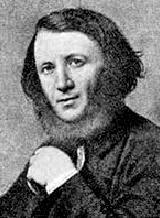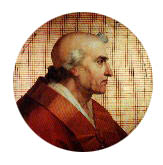|
Stephen VIIDuring the 800s and 900s, the Holy Roman Empire basically fell apart, reassembled itself and fell apart again several times. During this period, the papacy was primarily a tool of political intrigue, and theology was strictly an afterthought. This attitude led to such memorable popes as John XII (literally a mother-fucker), Sergius III, Benedict IX and, of course, the legendary Pope Joan, a woman who reportedly gave birth to an illegitimate child on her way to the basilica. Stephen VII didn't have as much of an opportunity to disgrace the Catholic Church as some of his contemporaries. He was only pope for a year. But what a year it was! Stephen himself appears to have been an extraordinarily dull individual in his life before the papacy. He was the son of a Roman priest who later became a bishop himself, possibly under protest, at the hands of Pope Formosus, an extraordinarily divisive figure in his day. Formosus had succeeded Stephen VI as pope in 891. As a bishop he had been excommunicated and subsequently recommunicated for his political leanings. As was customary in Italy at the time, those leanings were insanely arcane. The history of Formosus is worthy of a doctoral dissertation, which you aren't going to get here. Instead, help yourself to the following glib oversimplification:
Irrelevant or not, the bragging privileges associated with the title of emperor still counted for something, and many bishops and cardinals were not pleased with Charles, who ironically was not bald. These factions favored other such immortal historical figures as Empress Engelberga. Any fool knows that Empress Engelberga had ten times the political acumen of Charles the Bald. Or something like that. Truly, it could not be less important. As a result of all this crap, and a lot of even more obscure crap, Formosus fled Rome. Hell hath no fury like a woman pope scorned, and Pope Joan called a synod to condemn Formosus and demand his return to Rome, on pain of excommunication. Formosus was accused of a battery of crimes, including nun-fucking and conspiring against the pope. Eventually, he was defrocked and excommunicated.
Duke Guido of Spoleto became Holy Roman Emperor, and Formosus became pope shortly after. He was forced to endorse Guido as Emperor, and subsequently to do the same for his son, Lambert, then he backed Charles the Simple (who may possibly have been simple) as king of France, and then blah, blah, blah. They wonder why kids don't want to learn history. The upshot of all this was that Guido persecuted the popes and encroached on territory traditionally controlled by the Church, until Formosus secretly recruited Arnulf of Carinthia... Ah, screw this. Long story short, Formosus pissed off a lot of people before he died in 896.
Stephen convened "The Cadaver Synod" at St. John Lateran Basilica in 897 to pass judgment on his predecessor. The pope sat on his throne in front of an assembly of bishops and cardinals, including a cardinal who would later become Pope Sergius III. The defendant had been dead for seven months and his body was in an advanced state of decay. Formosus was given his own throne and dressed up in his papal garb for the occasion. A deacon was appointed to speak for Formosus, who was by every account quite taciturn throughout the proceeding. It was a thankless job. The deacon only managed to get a few words in when Stephen paused for breath. The live pope went on a historic tirade against the dead one, who turned the other cheek in a proper Christian manner. The scene was described almost a thousand years later by poet Robert Browning. While poetic license must be considered, Browning's rendition of Stephen's speech is probably a reasonable facsimile:
Since Formosus had failed to prepare an effective defense, he was convicted as having been unworthy of the papacy. His papacy was declared invalid and all his papal actions were voided. As Browning relates, the historical record shows that Stephen ordered the clothes ripped from the body of Formosus, and the three fingers used to issue papal blessings were cut from the corpse's right hand. His naked body was first buried in a pauper's cemetery, then dug up AGAIN and thrown into the Tiber river, where it bobbed about for some time before being recovered by a monk. Stephen didn't live long enough to enjoy his glorious victory in the debate with Formosus. Even in the bloody and perverted ninth century, some things were too much for the masses to endure. Stephen was deposed, imprisoned and subsequently strangled on the orders of his successor, who also restored Formosus to his original tomb. Unbelievably, the story didn't actually end there. For the next few decades, succeeding popes went through a series of squabbles, reversals and affirmations of the various rulings about the trial of Formosus. In the end, Stephen VII had the last laugh.
There are conflicting accounts about whether Sergius might have had Formosus exhumed yet again and subsequently beheaded, but Sergius did win the distinction of having the last word. Although no one today seriously believes the trial of Formosus could be considered valid by any sane person, the popes who came after Sergius declined to reconsider the proclamations of Sergius. The court case -- and the pontiff -- have remained dead and buried ever since. Legally, Formosus remains a corpse convict. He would probably roll over in his grave, if he wasn't afraid someone would cut off his shoulders.
|
 He is unpoped, and all he did I damn:
He is unpoped, and all he did I damn: Pope Sergius III (best known for murdering his own predecessor) was the last pope to officially rule on Formosus. He re-instituted the conviction of the cadaver, and he ordered Stephen VII glorified for ordering the posthumous trial.
Pope Sergius III (best known for murdering his own predecessor) was the last pope to officially rule on Formosus. He re-instituted the conviction of the cadaver, and he ordered Stephen VII glorified for ordering the posthumous trial.